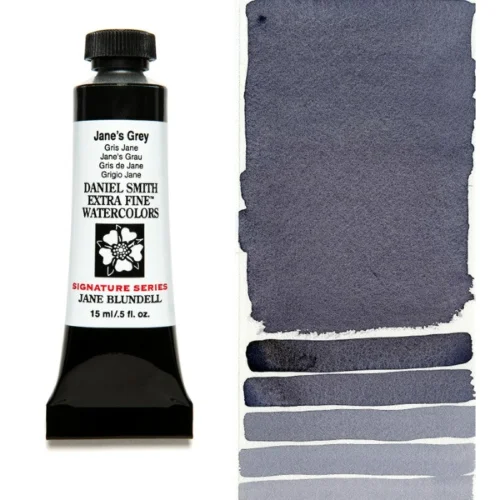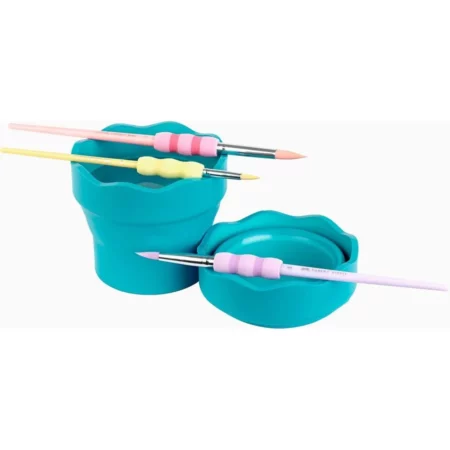Janes Grey S2 Daniel Smith Watercolour 15ml
R345.00
“Jane’s Grey is a unique colour in the market. Most grays, whether Payne’s Gray, Neutral Tint or others, are made with a black pigment, and often phthalo blue is included. Artist Jane Blundell wanted a gray without the often-dulling effect of a black pigment, and without the staining effects of phthalo blue. She wanted a gray that was liftable and granulating to create the lovely look of stormy skies and softened shadows. It will also work as a neutral tint, darkening colours without changing them. Using a gray that is made with palette colours maintains colour harmony in an artwork. Many artists mix ultramarine blue and burnt sienna as they work, but no one was making this gorgeous mix as a convenience colour, so she did to make it easy to create rich darks with ease. Initially she mixed it in individual pans and palettes but the demand from her students meant she started to make it in tubes.”
- Daniel Smith watercolours are the worldwide leaders of watercolour for artists with an extensive range of colours.
- Many colours are traditional colours relied upon by artist and there are many truly unique colours made only by Daniel Smith.
- These watercolours are formulated to meet and exceed the highest industry standards for the manufacture of artist’s paints, and every batch made is tested and analyzed for its performance qualities.
- Cadmium hues have been developed by Daniel Smith that are safe and vibrant with the density and richness of cadmium but without the cadmium pigment – they offer identical colour to the original cadmium but are cleaner and stronger in tints with the working properties of staining power, semi transparency and lightfastness being nearly identical to the low soluble cadmiums previously manufactured by Daniel Smith.
- Quinacridone colours which were developed for the automotive industry due to there extreme lightfastness and durability and been developed by Daniel Smith into a range with brilliant colour and luminous transparency.
- Prima Tek colours are made from minerals that have been ground into pigments, mixed with gum Arabic and then milled into Prima Tek colours – these are often semi-precious minerals such as Lapis Lazuli Genuine, Piemontite Genuine and Serpentine Genuine which have wonderful granulating effects.
- Luminescent watercolours have special optical effects for subjects that sparkle, sheen or have a reflective glow.
- Colours not available in store and online may be ordered in as per customer requests.
- 15ml tube.
Change the quantity above using the arrows (shown on hover) or manually input your desired amount.
Pigment: PB 60, PBk 6 | Series: 1
Lightfastness: I – Excellent
Transparency: Semi-Transparent
Staining: 2-Low Staining
Granulation: Non-Granulating
Daniel Smith Watercolours are formulated to meet and exceed the highest industry standards for the manufacture of artist’s paints, and every batch made is tested and analyzed for its performance qualities:
Lightfastness
Colour value
Tinting strength
Clarity
Vibrancy
Undertone
Particle size
Density
Viscosity
Watercolour FAQ’s
Why are some colours of watercolours easy to wash away after drying and other colours are not?
The fact that some colours remain on the paper and can only be partially washed away is due to the type of pigment (particle size) and/or the quality of the paper used.
How do you create bleeding with watercolour?
The bleeding technique is similar to the wet into wet technique (wetting your paper first with water, or painting into a wet area of colour), only instead of laying your brush on the surface, let the colour drip from above one into the next.
Tip – To control the bleed area, pre-wet only where you want the colour to go first.
Does a watercolour have to be varnished?
It is not absolutely necessary to varnish a watercolour, but varnish helps you protect your work from moisture and dirt. Remember that Watercolour Paint is not waterproof, so remember to follow application instructions when varnishing your artwork. You can also choose not to varnish your work, and instead place it in a frame with UV-resistant glass.
What does “granulation” mean?
Granulation is a property of some pigments which refers to pigments in the paint combining together in small groups once applied. This produces a flocculated or curdled effect that brings life to the colour surface.


